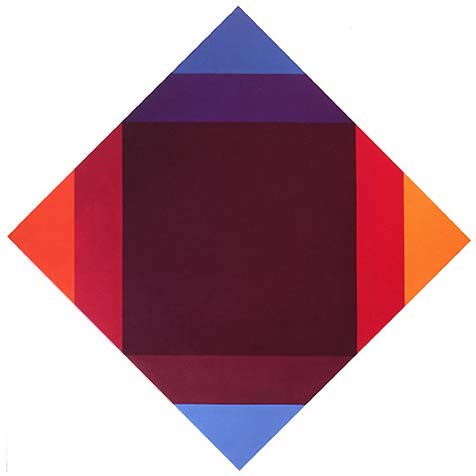|
|
|
Max
Bill
|

|
Max Bill
verdichtung zu caput mortuum
1972 / 73
100 x 100 cm, (diagonal: 141 cm)
Oil on canvas
© VG-Bild-Kunst, Bonn 2003
|
The
painting 'verdichtung zu caput mortuum' (distillation to caput mortuum)
is one of a series of variations, with different expressive
qualities deriving from the combination of colours used in each. The
series was started in 1964. All the pictures are placed on the diagonal
- Bill sometimes called them "pointed pictures".
This unusual external format feature alone expresses instability and
tension, compelling the eye to move around. In 'verdichtung zu caput
mortuum' the area in the centre is coloured a dull reddish-brown, or
caput mortuum - the term applied to a residue after distillation or
sublimation in alchemy. Here it acquires a special quality from the
external isosceles triangles and bands of colour, and becomes a surface
against which the yellow-red and bluish-purple colour chords can resonate
as they interact with the reddish-brown.
The "unambiguous concision" of the colour forms gives them
an inner depth and stability that contrast with the instability of the
pictorial form. The dead, square nucleus in the earth-colour caput mortuum
gains a life of its own.
Max Bill, a member of the Swiss 'Zurich Concrete' group, was an architect,
painter, sculptor, politician, educationalist, writer,
in short, a 'universal creator'. He analysed the principles of Concrete
Art and sharpened Theo
van Doesberg's definition as follows:
|
" we
call those works of art concrete that came into being on the basis
of their inherent resources and rules - without external borrowing
from natural phenomena, without transforming those phenomena, in other
words: not by abstraction. concrete art is independent in its characteristic
features. it is the expression of the human spirit, intended for the
human spirit, and it should have the sharpness, the clarity and the
perfection that must be expected from the human spirit. concrete painting
and sculpture imply creating something that is open to visual perception.
their creative resources are colours, space, light and movement … concrete
art is ultimately the pure expression of harmonious measure and law.
it orders systems and uses artistic resources to give life to these
orders … it strives for universality and yet it cultivates uniqueness.
it suppresses things individualistic in favour of the individual." Bill
also requires that art should find a mathematical mode of thought
to guarantee that the creative principles can be controlled. In the
mean time he sees this as only one of the possible methods, "a
useful aid, through which ideas can acquire visible form."
|
|
|